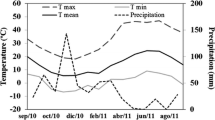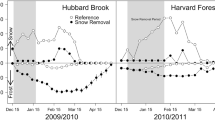Abstract
Both aboveground and belowground climate affects net primary production (NNP) and forest growth. Little is known about how above and belowground factors interact. The BIOMASS-model was tested to simulate photosynthetic recovery over a wide range of soil temperatures created by snow cover manipulations on tree-scale plots in a 20-year-old Scots pine stand in northern Sweden. The differences in timing of soil warming between the plots covered a span of two months. Carbon assimilation in needles, sap flow, needle water potential and climatic parameters were measured in the field. The simulations revealed that an early start of soil warming gave a relatively early photosynthetic recovery and a 7.5% increase of NPP. Late soil warming delayed the photosynthetic recovery and reduced the NPP by 13.7%. This indicated that soil temperature needed to be accounted for, as well as air temperature, when analysing photosynthetic recovery and NPP in boreal environment. The effects of differences in soil temperature were reflected in the simulated photosynthetic recovery. The model did not fully capture the delay of photosynthetic recovery caused by a late soil warming. It was possible to integrate the complexity of the soil climate effects into a threshold date for soil thaw, using sapflow measurements together with information about air temperature and a day degree sum, as long as water availability was not limiting water uptake by roots. Although a more realistic mechanism than that currently in BIOMASS is desirable as climate change shifts the typical patterns of interplay between air and soil temperature dynamics.





Similar content being viewed by others
References
Bamberg S, Schwarz W, Tranquillini W (1966) Influence of day length on the photosynthetic capacity of Stone pine (Pinus cembra L.). Ecology 48:264–269
Bergh J (1997) Climatic and nutritional constraint to productivity in Norway Spruce. Acta Universitatis Agriculturae Sueciae, Silvestria 37, 34 pp. Doctor’s disseration. ISSN 1401–6230. ISBN 91-576-5321-6
Bergh J, Linder S (1999) Effects of soil warming during spring on photosynthetic recovery in boreal Norway spruce stands. Global Change Biol 5:245–253
Bergh J, McMurtrie RE, Linder S (1998) Climatic factors controlling the productivity of Norway spruce: a model-based analysis. Forest Ecol Manage 110:127–139
Bergh J, Freeman M, Sigurdsson B, Kellomäki S, Laitinen K, Niinistö S, Peltola H, Linder S (2003) Modelling the short-term effects of climate change on the productivity of selected tree species in Nordic countries. Forest Ecol Manage 183:327–340
Cermak J, Deml M, Penka M (1973) A new model of sap flow rate method determination in trees. Biol Plant 15:171–178
Cermak J, Kucera J, Nadezhdina N (2004) Sap flow measurements with some thermodynamic methods, flow integration within trees and scaling up from sample trees to entire forest stands. Trees 18:529–546
De Lucia EH (1986) Effect of low root temperature on net photosynthesis, stomatal conductance and carbohydrate concentration in Engelmann spruce (Picea engelmannii Parry ex Engelm.) seedlings. Tree physiol 2:143–154
Ensminger I, Sveshnikov D, Campbell DA, Funks C, Jansson S, Lloyd J, Shibistova O Öquist G (2004) Intermittent low temperatures constrain spring recovery of photosynthesis in boreal Scots pine forests. Global Change Biol 10:995–1008
Gaastra P (1959) Photosynthesis of crop plants as influenced by light, carbon dioxide, temperature, and stomatal diffusion resistance. Meded Landbouwhogesch Wageningen 59:1–68
Haninen H, Kolari P, Hari P (2005) Seasonal development of Scots pine under climatic warming: effects on photosynthetic production. Can J For Res 35:2092–2099
Hardy JP, Groffman PM, Fitzhugh RD, Henry KS, Welman AT, Demers JD, Fahey TJ, Driscoll CT, Tierney GL, Nolan S (2001) Snow depth manipulation and its influence on soil frost and water dynamics in a northern hardwood forest. Biogeochemistry 56:151–174
Jarvis P, Linder S (2000) Constraints to growth of boreal forests. Nature 405:904–905
Kučera J, Cermak J, Penka M (1977) Improved thermal method of continual recording the transpiration flow rate dynamics. Biol Plant 19:413–420
Laitinen K, Luomala E-M, Kellomäki S, Vapaavuori E (2000) Carbon assimilation and nitrogen in needles of fertilized and unfertilized field-grown Scots pine at natural and elevated concentrations of CO2. Tree Physiol 20:881–892
Linder S, Lohammar T (1981) Amount and quality of information on CO2-exchange required for estimating annual carbon balance of coniferous trees. Stud For Suec 160:73–87
McMurtrie RE, Rook DA, Kelliher FM (1990) Modelling the yield of Pinus radiata on a site limited by water and nitrogen. Forest Ecol Manage 30:381–413
Mellander P-E, Bishop K, Lundmark T (2004) The influence of soil temperature on transpiration: a plot scale manipulation in a young Scots pine stand. Forest Ecol Manage 195:15–28
Mellander P-E, Laudon H, Bishop K (2005) Modelling variability of snow depths and soil temperatures in Scots pine stands. Agric Forest Meteorol 133:109–118
Mellander P-E, Stähli M, Gustafsson D, Bishop K (2006) Modelling the effect of low soil temperatures on transpiration by Scots pine. Hydrol Processes 20:1929–1944
Monson RK, Sparks JP, Rosenstiel TN, Scott-Denton LE, Huxman TE, Harley PC, Turnipseed AA, Burns SP, Backlund B, Hu J (2005) Climatic influences on net ecosystem CO2 exchange during the transition from wintertime carbon source to springtime carbon sink in a high-elevation, subalpine forest. Oecologia 146:130–147
Nash LE, Sutcliffe JV (1970) River flow forecasting through conceptual models. Part 1: a discussion of principles. J Hydrol 10:282–290
Odin H (1992) Climate and conditions in forest soils during winter and spring at Svartberget Experimental Station. Swed Univ Agric Sci, Dept Ecol Environ Res, Report 56
Pelkonen P (1980) The uptake of carbon dioxide in Scots pine during spring. Flora 169:386–397
Robitaille G, Boutin R, Lachance D (1994) Effects of soil freezing stress on sap flow and sugar content on mature sugar maples (Acer saccharum). Can J For Res 25:577–587
Sevanto S, Suni T, Pumpanen J, Gronholm T, Kolari P, Nikinmaa E, Hari P, Vesala T (2006) Wintertime photosynthesis and water uptake in a boreal forest. Tree physiol 26:749–757
Slatyer RO, Bierhuizen JF (1964) Transpiration from cotton leaves under a range of environmental conditions in relation to internal and external diffusive resistances. Aust J Biol Sci 17:115–130
Strand M (1995) Inhibition of photosynthesis in current-year needles of unfertilised and fertilised Norway spruce (Picea abies (L.) Karst.) during autumn and early winter. Trees 9:332–340
Strand M, Lundmark T, Söderbergh I, Mellander P-E (2002) Impacts of seasonal temperatures on photosynthesis in Scots pine trees. Tree Physiol 22:839–847
Suni T, Berninger F, Vesala T, Markkanen T, Hari P, Mäkelä A, Ilvesniemi H, Hänninen H, Nikinmaa E, Huttula T, Laurila T, Aurela M, Grelle A, Lindroth A, Arneth A, Shibistova O, Lloyd J (2003) Air temperature triggers the recovery of evergreen boreal forest photosynthesis in spring. Global Change Biol 9:1410–1426
Wang K-Y, Kellomäki S (1997) Effects of elevated CO2 and soil-nitrogen supply on chlorophyll fluorescence and gas exchange in Scots pine, based on a branch-in-bag experiment. New Phytol 136:277–286
Wang K-Y, Kellomäki S, Laitinen K (1996) Acclimation of photosynthetic parameters in Scots pine after three years exposure to elevated temperature and CO2. Agric Forest Meteorol 82:195–217
Waring RH, Cleary BD (1967) Plant moisture stress: Evaluation by pressure bomb. Science 155:1248–1254
Acknowledgments
This study was performed within the EU funded research program “The Utilisation of the Boreal Forest”.
Author information
Authors and Affiliations
Corresponding author
Additional information
Communicated by Rainer Matyssek.
Rights and permissions
About this article
Cite this article
Mellander, PE., Bergh, J., Lundmark, T. et al. Recovery of photosynthetic capacity in Scots pine: a model analysis of forest plots with contrasting soil temperature. Eur J Forest Res 127, 71–79 (2008). https://doi.org/10.1007/s10342-007-0184-4
Received:
Revised:
Accepted:
Published:
Issue Date:
DOI: https://doi.org/10.1007/s10342-007-0184-4




